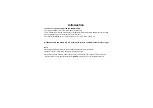
NPD-1
Troubleshooting — RF
CCS Technical Documentation
Page 24
Nokia Corporation Confidential
Issue 1 11/2002
Manual Verification: Same as previous tuning, except choose the CDMA 2000 tuning in
the RF Tuning window.
Troubleshooting: Same as previous tuning.
TS ACPR PCS- Low (High)
Adjacent Channel Power Ratio (ACPR) is a measure of band power in the adjacent chan-
nel as compared to the tuned channel, so it is a power delta in dB. Band power is mea-
sured at the center tuned frequency and also at an offset lower (higher) than the center
frequency, and the difference is ACPR. For this test, the offset is –1.25 MHz (+1.25 MHz).
Band power is integrated power over a frequency band, rather than at a single frequency.
The bandwidth for the measurement centered at the tuned frequency is the bandwidth
of the signal, which for IS95 is 1.23 MHz. The bandwidth used at the offsets is 30 kHz.
Result is ACPR (a power delta) in dB.
Manual Verification: Set the phone in local mode, and turn on the PCS transmitter set to
channel 600. Use the TX Limiting function in the RF Tuning window to set the transmit
power to the maximum value (within the limits for the “TX Limiting” tuning).
Observe the TX signal on the spectrum analyzer. If the spectrum analyzer being used has
a CDMA personality card, ACPR can be read directly off the screen. If not, then set the
bandwidth to 30 kHz, and set the averaging on. Center the marker at 1880 MHz and note
the power in dBm. Use the offset marker to measure the power at an offset of -1.25 MHz
(+1.25 MHz). Subtract the two power readings, then add 16 dB to compensate for the
fact that the power at the center frequency was measured with a 30 kHz bandwidth
rather than 1.23 MHz. Figures 3 and 4
below show examples of good and bad ACPR.
Figure 3: Good ACPR (analyzer screenshot)
















































